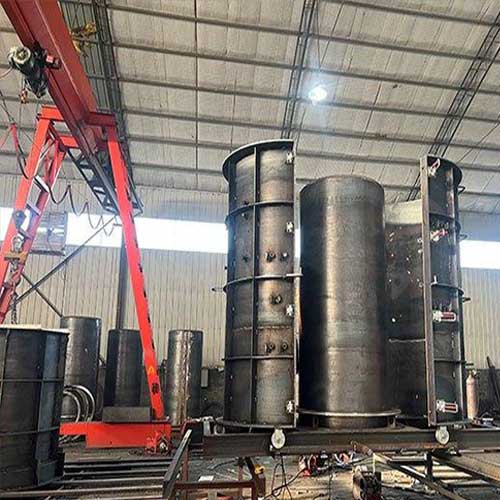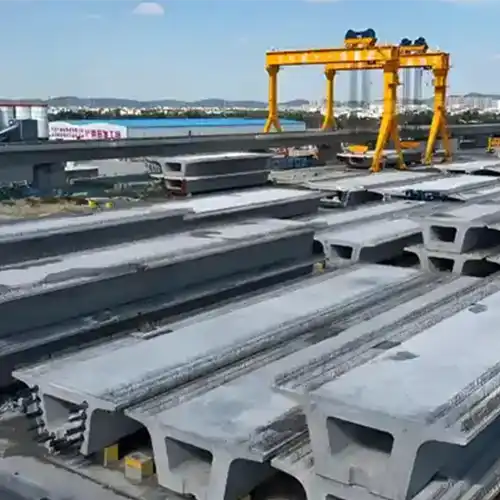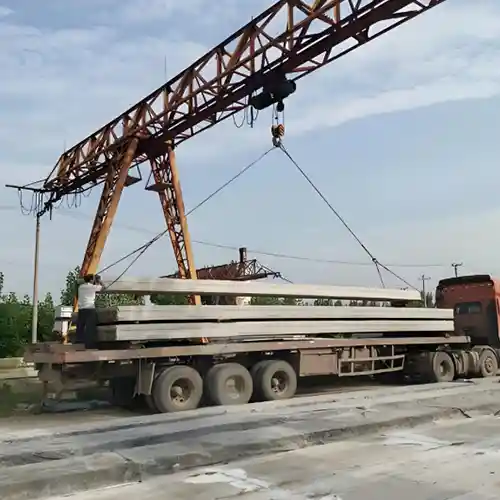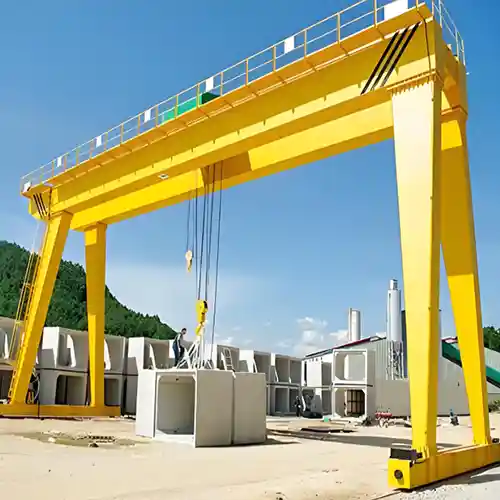Gantry Cranes & Overhead Cranes for Large Formworks & Concrete Molds Handling
Gantry cranes and overhead cranes for handling large formworks & concrete molds in construction. Get your custom material handling crane 1 ton to 50 ton.
Category: Construction
Comprehensive Guide on
Your Trusted Material Handling Overhead Crane Manufacturer & Supplier
Large Formwork Concrete Mold Handling Cranes Comprehensive Guide
Material Handling Overhead Cranes and Gantry Cranes in Large Formwork Systems in Construction Sectors
Efficient material handling lies at the heart of successful construction projects, particularly in the realm of large formwork systems. As construction sites evolve to meet the demands of intricate structures such as highrise buildings, bridges, and dams, the significance of adept material handling, encompassing the nuanced aspect of mold handling, becomes increasingly paramount.
Material handling is not merely a logistical facet of construction; it is the backbone that supports the entire building process. In the context of large formwork systems, where precision and structural integrity are nonnegotiable, the manner in which materials, including molds, are transported, positioned, and assembled holds the key to project success.
- Precision and Timeliness: Efficient material handling ensures that formwork components, especially molds, are delivered to the right location with precision. This precision, coupled with timely deliveries, accelerates construction timelines and contributes to project efficiency.
- Enhanced Safety Measures: The proper handling of materials, including molds, is fundamental to ensuring the safety of the construction site. Adhering to meticulous handling procedures minimizes the risk of accidents and protects the workforce and valuable assets.
- Optimization of Workflow: Wellexecuted material handling strategies streamline the construction workflow. From the arrival of raw materials to the transportation of finished products, including assembled molds, a seamless process contributes to overall project optimization.
- CostEffectiveness: Effective material handling translates into costeffectiveness. Reduced downtime, minimized material wastage, and efficient utilization of resources, including molds, contribute to the financial viability of construction endeavors.
- Structural Integrity: Large formwork systems demand a high degree of precision to ensure the structural integrity of the final build. Proper material handling, especially when dealing with molds, guarantees that each component fits seamlessly into the larger puzzle, creating a robust and durable structure.
Recognizing the vital role that material handling, encompassing mold handling, plays in construction sets the stage for a comprehensive exploration of the types of cranes, their applications, and the benefits they bring to the dynamic landscape of large formwork systems. As we delve into the intricacies of crane utilization in the subsequent sections, it becomes clear that the efficiency of material handling is a linchpin in the success of construction projects that rely on large formwork systems.
Types of Cranes Used in Large Formwork Systems
In the intricate dance of material handling within large formwork systems, the choice of cranes becomes a critical determinant of project success. Let's navigate through the diverse array of cranes, each playing a crucial role in the efficient handling of materials, molds included.
Overhead Cranes
Bridge cranes, also known as overhead bridge cranes or overhead traveling cranes, are versatile and commonly used in construction. They consist of parallel runways with a traveling bridge spanning the gap, equipped with a hoist for vertical lifting. Bridge cranes are ideal for moving heavy loads horizontally and vertically, making them suitable for various stages of large formwork systems, from raw material transport to assembly.

Single Girder Overhead Cranes Series - European style electric hoists Crane Type, Custom Double hook overhead crane
Crane Design & Capacities:
Single girder overhead cranes have a single horizontal beam that spans the width of the crane runway.
Capacities can range from a few tons to several dozen tons, depending on the specific requirements of the manufacturing plant.
Tailored Features for Operation in Large Formwork Systems Manufacturing:
Adaptability: Designed to handle the unique shapes and sizes of formwork components.
Precise Control: Equipped with precise control mechanisms for accurate positioning during assembly and material handling.
Versatility: Customizable configurations to suit the diverse needs of large formwork systems.
Applicable Procedures: Ideal for tasks such as transporting raw materials, lifting and positioning large formwork components, and assisting in assembly and subassembly processes.
Crane Installation Locations: Positioned strategically across different workstations within the manufacturing plant to ensure optimal coverage.
Typical Loads or Object Handlings:
Large Formwork Components: Efficiently lifts and positions components such as panels, beams, and columns.
Raw Materials: Handles transportation of raw materials like steel, aluminum, plywood, and other components.
Assembly Workstations: Facilitates the movement of partially assembled formwork components between workstations.

Double Girder Overhead Cranes Series
Crane Design & Capacities:
Double girder overhead cranes have two horizontal beams that run on top of the crane runway.
Capacities are typically higher compared to single girder cranes, making them suitable for heavyduty applications.
Tailored Features for Operation in Large Formwork Systems Manufacturing:
High Lifting Capacity: Designed to handle substantial loads, including large and heavy formwork components.
Customizable Configurations: Adaptable to various formwork dimensions and designs.
Applicable Procedures: Suited for heavyduty tasks such as transporting large formwork components, handling raw materials, and facilitating assembly processes.
Crane Installation Locations: Installed strategically in areas where heavy lifting and precise positioning are crucial, typically at key points in the manufacturing process.
Typical Loads or Object Handlings:
Large Formwork Components: Lifts and positions substantial elements with precision.
Welding and Fabrication Shops: Handles the transportation of welded components for further processing.
Mold Handling: Specifically designed for precise and safe handling of molds during the manufacturing process.
This overview provides a glimpse into the tailored features and applications of Single Girder and Double Girder Overhead Cranes in Large Formwork Systems Manufacturing Plants, showcasing their adaptability and importance in the construction industry.
Jib Cranes:
Jib cranes feature a horizontal arm (jib) that pivots around a vertical axis. They are often mounted on vertical pillars or walls, providing a circular or semicircular range of motion for lifting loads.
Jib cranes excel in localized lifting tasks, making them valuable for specific workstations within large formwork systems, such as assembly points and quality control stations.
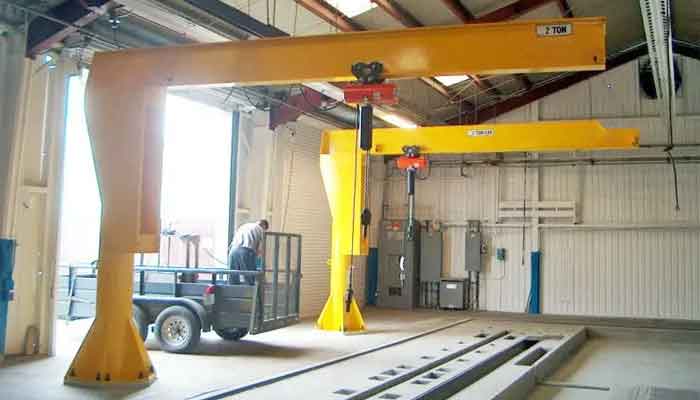
Floor Mounted Pillar Jib Cranes
Crane Design & Capacities:
Floor Mounted Pillar Jib Cranes consist of a vertical pillar that is securely mounted to the floor, supporting a horizontal jib arm.
Capacities vary based on the specific requirements of the manufacturing plant but typically range from a few hundred kilograms to several tons.
Tailored Features for Operation in Large Formwork Systems Manufacturing:
360Degree Rotation: Provides fullcircle coverage, allowing for efficient material handling within the designated workspace.
Adaptable Design: Can be customized to accommodate the unique layout and needs of large formwork systems.
Applicable Procedures:
Suited for tasks such as loading and unloading large formwork components, transporting materials within a specific area, and assisting in assembly processes.
Crane Installation Locations:
Typically installed on the manufacturing floor where there is a need for localized and flexible material handling.
Typical Loads or Object Handlings:
Large Formwork Components: Lifts and moves components within a specific area.
SubAssembly Workstations: Assists in the movement of partially assembled formwork elements between workstations.
Material Transport: Efficiently transports materials for assembly and processing within a designated radius.
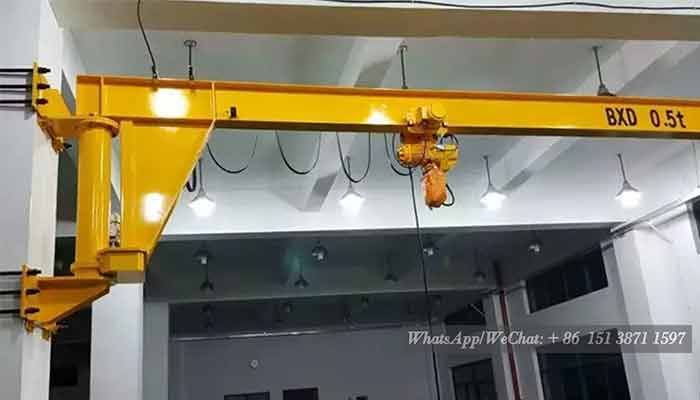
Wall or Column Mounted Jib Cranes
Crane Design & Capacities:
Wall or Column Mounted Jib Cranes are fixed to a vertical wall or column, featuring a horizontal jib arm that provides lateral movement.
Capacities vary, with options available to suit the specific requirements of the manufacturing plant.
Tailored Features for Operation in Large Formwork Systems Manufacturing:
SpaceSaving Design: Ideal for environments where floor space is a consideration, as the crane is mounted to existing structures.
Flexible Rotation: Provides lateral movement and rotation, enhancing adaptability to different material handling scenarios.
Applicable Procedures: Suited for tasks such as localized material handling, loading and unloading, and assisting in assembly processes within a specific area.
Crane Installation Locations: Mounted on existing structures such as walls or columns, saving valuable floor space in the manufacturing plant.
Typical Loads or Object Handlings:
Localized Material Handling: Efficiently moves and positions formwork components within a designated workspace.
Loading and Unloading Stations: Assists in the transfer of materials between workstations.
Assembly Line Support: Facilitates the movement of components in subassembly areas.
This overview provides insights into the features and applications of Floor Mounted Pillar Jib Cranes and Wall or Column Mounted Jib Cranes in Large Formwork Systems Manufacturing Plants, emphasizing their flexibility and efficiency in material handling operations.
Gantry Cranes
Single Leg Gantry Cranes: Single leg gantry cranes have a single supporting leg and a horizontal bridge that spans the workspace. They offer flexibility in movement and are often used in applications where floor space needs to be maximized. Single leg gantry cranes are adept at handling large formwork components, including molds, in areas where a traditional overhead crane setup may be challenging.
Double Leg Gantry Cranes: Double leg gantry cranes feature two supporting legs, providing enhanced stability and loadbearing capacity. The horizontal bridge between the legs allows for smooth movement across the workspace. Double leg gantry cranes are employed in scenarios demanding higher lifting capacities, making them suitable for transporting and positioning large and heavy formwork components, including molds.
As we navigate the realm of large formwork systems, understanding the nuances of each crane type becomes paramount. The versatility of overhead cranes, with their bridge and jib variations, complements the localized efficiency of gantry cranes with single or double legs. These crane variations, each tailored to specific needs, form the backbone of material handling, ensuring that every component, especially molds, is maneuvered with precision and reliability. In the subsequent sections, we will delve deeper into the applications and benefits of these cranes in the context of large formwork systems.

Single Girder Gantry Cranes with European style Electric Hoists
Crane Design & Capacities:
Single Girder Gantry Cranes have a single horizontal beam supported by two legs and run on rails, providing a versatile lifting solution.
Capacities vary widely, ranging from a few tons to several dozen tons, depending on the specific requirements of the manufacturing plant.
Tailored Features for Operation in Large Formwork Systems Manufacturing:
Adaptability: Designed to handle the unique shapes and sizes of formwork components.
Precise Control: Equipped with precise control mechanisms for accurate positioning during assembly and material handling.
Versatility: Customizable configurations to suit the diverse needs of large formwork systems.
Applicable Procedures:
Ideal for tasks such as transporting raw materials, lifting and positioning large formwork components, and assisting in assembly and subassembly processes.
Crane Installation Locations:
Positioned strategically across different workstations within the manufacturing plant to ensure optimal coverage.
Typical Loads or Object Handlings:
Large Formwork Components: Efficiently lifts and positions components such as panels, beams, and columns.
Raw Materials: Handles transportation of raw materials like steel, aluminum, plywood, and other components.
Assembly Workstations: Facilitates the movement of partially assembled formwork components between workstations.
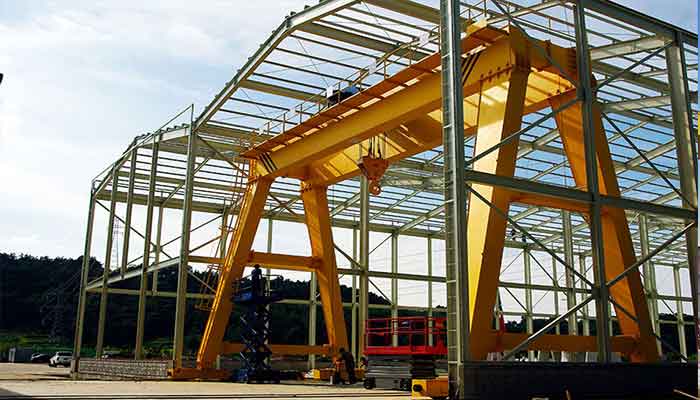
Crane Design & Capacities:
Double Girder Gantry Cranes have two horizontal beams supported by legs, offering increased lifting capacity compared to single girder cranes.
Capacities are typically higher, making them suitable for heavyduty applications in large formwork systems.
Tailored Features for Operation in Large Formwork Systems Manufacturing:
High Lifting Capacity: Designed to handle substantial loads, including large and heavy formwork components.
Customizable Configurations: Adaptable to various formwork dimensions and designs.
Applicable Procedures:
Suited for heavyduty tasks such as transporting large formwork components, handling raw materials, and facilitating assembly processes.
Crane Installation Locations:
Installed strategically in areas where heavy lifting and precise positioning are crucial, typically at key points in the manufacturing process.
Typical Loads or Object Handlings:
Large Formwork Components: Lifts and positions substantial elements with precision.
Welding and Fabrication Shops: Handles the transportation of welded components for further processing.
Mold Handling: Specifically designed for precise and safe handling of molds during the manufacturing process.
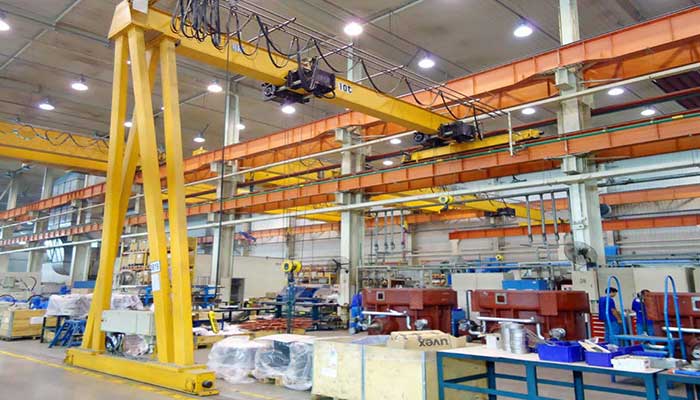
Crane Design & Capacities:
Single Leg Gantry Cranes have a single supporting leg on one side and run on rails, providing a spacesaving solution for specific applications.
Capacities range depending on the specific requirements of the manufacturing plant.
Tailored Features for Operation in Large Formwork Systems Manufacturing:
SpaceSaving Design: Suitable for environments where floor space is a consideration.
Flexible Movement: Allows for lateral movement and positioning of formwork components with precision.
Applicable Procedures:
Suited for tasks where localized material handling and precise positioning are crucial within a designated area.
Crane Installation Locations:
Installed where space efficiency is essential, providing flexibility in the layout of the manufacturing plant.
Typical Loads or Object Handlings:
Localized Material Handling: Efficiently moves and positions formwork components within a designated workspace.
Loading and Unloading Stations: Assists in the transfer of materials between workstations.
Assembly Line Support: Facilitates the movement of components in subassembly areas.
This overview provides insights into the features and applications of Single Girder Gantry Cranes, Double Girder Gantry Cranes, and Single Leg Gantry Cranes in Large Formwork Systems Manufacturing Plants, emphasizing their adaptability, lifting capacities, and efficiency in material handling operations.
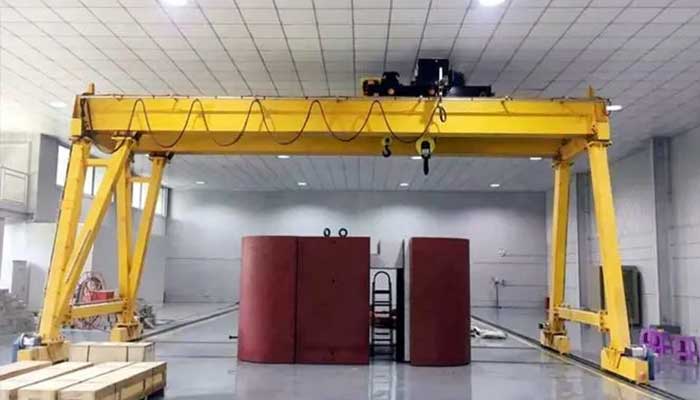
Crane Design & Capacities:
Double Leg Gantry Cranes have two supporting legs on either side, providing stability and enhanced lifting capacities.
Capacities are higher compared to single leg gantry cranes, making them suitable for heavyduty applications.
Tailored Features for Operation in Large Formwork Systems Manufacturing:
Enhanced Stability: The dualleg design ensures stability when lifting heavy formwork components.
Customizable Configurations: Adaptable to handle various formwork sizes and shapes.
Applicable Procedures:
Suited for tasks that require a combination of stability, precision, and high lifting capacity, such as handling large and heavy formwork components.
Crane Installation Locations:
Installed in key areas where stability and high lifting capacity are crucial, typically at critical points in the manufacturing process.
Typical Loads or Object Handlings:
Heavy Formwork Components: Lifts and positions large and weighty formwork elements with stability.
Assembly Stations: Facilitates the movement of components during the assembly process.
Material Transport: Efficiently transports heavy raw materials within the designated workspace.
Additional Considerations for Gantry Cranes in Large Formwork Systems:
- Outdoor Gantry Cranes: Some gantry cranes are designed for outdoor use, featuring weatherresistant materials to withstand environmental conditions. These are suitable for applications where materials need to be moved between indoor and outdoor spaces.
- Automation and Control Systems: Gantry cranes can be equipped with advanced automation and control systems, including remote control operation, to enhance efficiency and precision in material handling.
- Rail Mounted Gantry Cranes (RMG): In certain largescale manufacturing plants, railmounted gantry cranes are utilized. These cranes run on tracks or rails, providing a highly efficient and precise method of moving materials over a large area.
- Specialized Attachments: Gantry cranes can be equipped with specialized attachments, such as vacuum lifters or clamps, to handle specific types of formwork components or materials.
- Safety Features: Gantry cranes come with a range of safety features, including overload protection, emergency stop systems, and collision avoidance technology, ensuring a secure working environment.
- Integration with Plant Management Systems: Gantry cranes can be integrated into the overall plant management system, allowing for seamless coordination with other manufacturing processes.
The selection of the appropriate gantry crane type depends on the specific requirements of the large formwork systems manufacturing plant, considering factors such as load capacities, space constraints, and the nature of materials being handled. Integrating a mix of gantry crane types based on the manufacturing needs ensures a comprehensive and efficient material handling solution.
Material Handling Cranes: Applications and Benefits
In the orchestration of material handling within large formwork systems, overhead cranes emerge as versatile maestros, seamlessly conducting a symphony of tasks. Let's delve into the typical applications where overhead cranes shine, including their pivotal role in raw material transport, assembly workstations, and the precise handling of molds at quality control stations.

Typical Applications of Overhead Cranes
- Raw Material Transport: Efficient Movement: Overhead cranes, especially bridge cranes, take center stage in the transport of raw materials within a large formwork manufacturing plant. The parallel runways and hoist system allow for swift and precise movement, optimizing the delivery of raw materials to designated workstations.
- Assembly Workstations: Seamless Assembly: Overhead cranes play a vital role in the assembly process of large formwork components. The ability to maneuver horizontally and vertically facilitates the seamless integration of different elements, contributing to the efficient construction of intricate structures.
- Mold Handling and Quality Control Stations: Precision Handling: One of the distinctive applications of overhead cranes is in the handling of molds. Whether transporting molds between workstations or positioning them at quality control stations, the precision control of overhead cranes ensures that molds are handled with care and accuracy.
Benefits of Overhead Cranes in Material Handling
- High Lifting Capacity: Versatility: Overhead cranes boast high lifting capacities, making them adaptable to the varied weight requirements of large formwork components, including molds.
- Precise Control and Positioning: Accuracy: The ability to precisely control the movement of overhead cranes ensures accurate positioning of materials, a critical factor in the construction of complex structures.
- Adaptability to Various Materials: Versatility: Overhead cranes are designed to handle a variety of materials, from steel and aluminum to plywood, offering flexibility in the manufacturing process.
- Safety Features: Risk Mitigation: Overhead cranes come equipped with safety features such as overload protection and emergency stop systems, ensuring a secure working environment.
- Ease of Maintenance: Operational Efficiency: The design of overhead cranes facilitates ease of maintenance, minimizing downtime and contributing to continuous operational efficiency.
As we witness the applications and benefits of overhead cranes in the realm of large formwork systems, it becomes evident that these material handling champions are not just tools; they are indispensable partners in the journey of constructing robust and intricate structures. The subsequent sections will unravel more layers, exploring the applications and advantages of gantry cranes, further enriching our understanding of the dynamic landscape of material handling in construction.
Typical Applications of Gantry Cranes
Gantry cranes including the box girder gantry crane and truss girder gantry cranes, with their distinctive design and mobility, bring a unique set of applications to the stage of material handling within large formwork systems. Let's illuminate the stage, exploring how these cranes take center stage in loading and unloading formwork components and orchestrating seamless transportation within the facility.
- Loading and Unloading of Formwork Components: Efficient Vertical Movement: Gantry cranes, whether single or double legged, excel in the loading and unloading of large formwork components. Their vertical lifting capacity, combined with the ability to traverse horizontally, facilitates the smooth transfer of heavy formwork elements, ensuring a steady and precise loading and unloading process.
- Transportation Within the Facility: Flexibility in Movement: The mobility of gantry cranes becomes particularly valuable when it comes to transporting formwork components within the manufacturing facility. Whether moving components from one workstation to another or orchestrating the flow of materials on the factory floor, gantry cranes contribute to the efficient transportation of formwork elements.

Benefits of Gantry Cranes in Material Handling
- Mobility: Versatility in Movement: Gantry cranes, especially the single and double leg variants, offer exceptional mobility. This allows for the precise positioning of formwork components, enhancing the flexibility of material handling within the facility.
- Stability and LoadBearing Capacity: Handling Heavy Loads: The design of gantry cranes provides stability, crucial for handling heavy loads associated with large formwork components. Double leg gantry cranes, in particular, offer enhanced loadbearing capacity, accommodating the weight of sizable formwork elements.
- Adaptability to Different Workspaces: Customizable Configurations: Gantry cranes can be configured to suit different workspaces within the facility. Their adaptability ensures that they can efficiently handle formwork components of varying sizes and shapes.
- Flexibility in Outdoor Applications: Outdoor Maneuverability: Gantry cranes, especially single leg variants, are wellsuited for outdoor applications. This adaptability extends the material handling capabilities to exterior spaces within the facility.
- Ease of Installation: Quick Setup: Gantry cranes are known for their relatively easy installation. Quick setup times contribute to operational efficiency and reduce downtime in the manufacturing process.
Gantry cranes, with their mobility and loadbearing prowess, carve out a distinctive role in the narrative of material handling within large formwork systems. From the loading and unloading of formwork components to orchestrating the intricate dance of transportation within the facility, gantry cranes take the stage as agile performers in the construction symphony. As we progress, the guide will unveil more layers, delving into the features, benefits, and industrial applications of these indispensable material handling tools.
Benefits of Overhead and Gantry Cranes in Material Handling
Material handling within large formwork systems requires a symphony of capabilities, and overhead and gantry cranes stand out as virtuoso performers. Let's dissect the quintet of benefits that these cranes bring to the construction stage: high lifting capacity, precise control and positioning, adaptability to various materials, safety features, and ease of maintenance.
- High Lifting Capacity: Versatility in Handling Heavy Loads: Both overhead and gantry cranes are engineered for substantial lifting capacities. This characteristic is pivotal in the construction of large formwork systems where components, including molds, can be of considerable weight. The ability to lift and transport these loads with ease ensures the efficiency and productivity of the manufacturing process.
- Precise Control and Positioning: Accuracy in Material Placement: A defining feature of both crane types is the precision with which they can be controlled. Whether positioning formwork components during assembly or delicately handling molds at quality control stations, the precise control of these cranes guarantees accurate and controlled material placement.
- Adaptability to Various Materials: Versatility in Material Handling: Overhead and gantry cranes are not confined to handling a specific type of material. From steel and aluminum to plywood and molds, these cranes exhibit adaptability to various materials commonly used in large formwork systems. This versatility streamlines the material handling process, contributing to a flexible and dynamic construction environment.
- Safety Features: Enhanced Workplace Safety: The safety of the workforce and the protection of valuable materials are paramount in construction. Both crane types come equipped with safety features such as overload protection, emergency stop systems, and advanced controls that mitigate risks and ensure a secure working environment.
- Ease of Maintenance: Minimized Downtime: Efficient manufacturing relies on machinery that is not only robust but also easy to maintain. Overhead and gantry cranes are designed with this in mind, offering features that simplify maintenance tasks. Reduced downtime for maintenance contributes to continuous operational efficiency and ensures that the cranes remain reliable components of the material handling process.
The benefits of overhead and gantry cranes extend far beyond their mechanical capabilities. Their high lifting capacity, precise control, adaptability, safety features, and ease of maintenance converge to create a harmonious and efficient material handling process within large formwork systems. Understanding the orchestration of these benefits in the construction landscape sets the stage for exploring their diverse applications in the subsequent sections of this comprehensive guide.
Special Features and Requirements of Cranes in Formwork Manufacturing Plants
Formwork manufacturing plants demand a specific set of capabilities from cranes to ensure a seamless and efficient material handling process. Let's delve into the extensive array of special features and requirements that make cranes indispensable in the context of large formwork systems.
- Heavy Lifting Capacity: Requirement: The ability to lift heavy loads is fundamental in formwork manufacturing. Cranes must have a high lifting capacity to handle substantial components, including large formwork panels and molds.
- Wide Span and Large Coverage: Requirement: The manufacturing floor in formwork plants often spans large areas. Cranes with a wide span and extensive coverage are essential for efficiently reaching different workstations and ensuring comprehensive material handling.
- Customizable Configurations: Requirement: Formwork components come in diverse shapes and sizes. Cranes with customizable configurations can be adapted to specific manufacturing needs, accommodating the variations in formwork dimensions and designs.
- Precise Control and Positioning: Requirement: Precision is paramount in formwork assembly. Cranes must offer precise control and positioning capabilities to ensure accurate placement of components, especially intricate elements like molds.
- Adaptability to Various Materials: Requirement: Formwork manufacturing involves working with different materials such as steel, aluminum, and plywood. Cranes need to exhibit adaptability, seamlessly handling the variety of materials used in the construction of formwork components.
- Specialized Attachments: Requirement: The versatility of cranes can be enhanced with specialized attachments. These attachments may include hooks, clamps, or vacuum systems designed to securely lift and transport specific formwork components, ensuring stability during handling.
- Durability and Robust Construction: Requirement: The demanding nature of formwork manufacturing requires cranes to be durable and robust. They should withstand the rigors of heavyduty usage and continue to perform reliably in a manufacturing environment.
- Safety Features: Requirement: Safety is paramount in any manufacturing plant. Cranes should be equipped with advanced safety features, including overload protection, emergency stop systems, and collision avoidance technology, to safeguard both personnel and valuable materials.
- Remote Control Operation: Requirement: Remote control operation adds an extra layer of convenience and safety. Cranes with remote control capabilities allow operators to oversee material handling from a distance, ensuring optimal visibility and control.
- Ease of Maintenance: Requirement: Minimizing downtime is crucial for maintaining operational efficiency. Cranes designed for ease of maintenance simplify routine tasks, allowing for quick inspections and repairs without prolonged interruptions to manufacturing processes.
- Environmental Considerations: Requirement: Cranes in formwork manufacturing plants should consider environmental factors. This includes features such as energy efficiency and reduced noise levels to create a sustainable and workerfriendly manufacturing environment.
- Integration with Plant Management Systems: Requirement: Seamless integration with plant management systems enhances efficiency. Cranes that can be integrated into the overall manufacturing process contribute to streamlined workflows and better coordination.
- Versatility in Movement: Requirement: The ability of cranes to move seamlessly in multiple directions enhances their versatility. This is crucial for navigating through the various workstations within the formwork manufacturing plant.
- Load Measurement and Monitoring: Requirement: Monitoring loads during material handling is essential for safety and efficiency. Cranes equipped with load measurement and monitoring systems provide realtime data, ensuring that loads stay within safe operating limits.
- Adherence to Industry Standards: Requirement: Compliance with industry standards is nonnegotiable. Cranes in formwork manufacturing plants must adhere to relevant safety and performance standards to ensure their reliability and legal compliance.
The success of formwork manufacturing hinges on the capabilities of the cranes employed in material handling. These special features and requirements outlined above not only showcase the technical prowess of cranes but also underscore their pivotal role in creating a manufacturing environment that prioritizes safety, precision, and efficiency. As we progress, we will uncover how these features translate into realworld applications within formwork manufacturing plants.
General Layout of Material Handling Cranes in Formwork Manufacturing Plants
Efficiency in a formwork manufacturing plant is intricately tied to the layout of material handling cranes. A welldesigned layout ensures a seamless workflow, from raw material intake to the final product's dispatch. Let's explore the key stations and areas where material handling cranes play a crucial role in optimizing the manufacturing process.
Raw Material Storage Area:
Cranes Involved: Overhead cranes with high lifting capacity.
Role: Transporting raw materials, such as steel, aluminum, and plywood, from storage to cutting and shaping stations.
Cutting and Shaping Station:
Cranes Involved: Overhead cranes with precise control.
Role: Assisting in the precise positioning of materials for cutting and shaping processes, ensuring accuracy in formwork component dimensions.
Assembly Workstations:
Cranes Involved: Overhead cranes and gantry cranes.
Role: Facilitating the movement of partially assembled formwork components between workstations for seamless assembly.
Welding and Fabrication Shops:
Cranes Involved: Overhead cranes with customizable configurations.
Role: Handling welded components, transporting them for further fabrication, and positioning them for additional processing.
Quality Control and Inspection Stations:
Cranes Involved: Overhead cranes with precise control.
Role: Transporting formwork components to quality control stations, ensuring meticulous inspection and adherence to specifications.
Customization and Modification Stations:
Cranes Involved: Overhead cranes and gantry cranes.
Role: Assisting in the movement of formwork components for customization and modification based on specific project requirements.
Assembly Line and SubAssembly Stations:
Cranes Involved: Overhead cranes and gantry cranes.
Role: Supporting the assembly line by transporting subassemblies and components between stations.
Mold Handling, Finished Product Storage, and Loading Area:
Cranes Involved: Overhead cranes and gantry cranes.
Role: Handling molds with precision, transporting finished formwork products, and facilitating loading operations for dispatch.
Shipping and Receiving Area:
Cranes Involved: Overhead cranes with wide span and large coverage.
Role: Managing the movement of formwork components in the shipping and receiving area for loading and unloading operations.
Maintenance and Storage Area for Cranes:
Cranes Involved: Overhead cranes with ease of maintenance features.
Role: Providing a designated space for crane maintenance, inspections, and ensuring the longevity of the material handling equipment.
The layout of material handling cranes within a formwork manufacturing plant is a choreographed dance, with each crane type playing a specific role in optimizing workflow. From the initial raw material intake to the final product's dispatch, a thoughtfully designed layout ensures that cranes operate seamlessly, contributing to the efficiency and precision of the entire manufacturing process. As we proceed, the guide will delve deeper into the realworld applications of cranes in each of these stations, showcasing their pivotal role in formwork manufacturing.
Typical Loads Handled by Overhead Cranes and Gantry Cranes in Formwork Manufacturing Plants
In the dynamic landscape of a formwork manufacturing plant, overhead cranes and gantry cranes shoulder the responsibility of handling diverse loads crucial to the construction of intricate structures. Let's delve into the typical loads these cranes deftly manage, showcasing their versatility and indispensability in the formwork manufacturing process.
- Large Formwork Components: Overhead cranes and gantry cranes are designed with the strength and precision needed to lift and position large and heavy formwork components. This includes formidable elements like panels, beams, and columns, which form the backbone of the final structures.
- Raw Materials and Components: The transportation of raw materials is a pivotal task within a formwork manufacturing plant. Cranes efficiently move materials such as steel, aluminum, plywood, and other essential components to various workstations, ensuring a continuous flow of materials for the manufacturing process.
- Assembly and SubAssembly: Overhead cranes and gantry cranes play a key role in the assembly and subassembly processes, aiding in bringing together different components of the formwork systems. This includes the careful handling of components that eventually form the molds and structural elements of the final product.
- Mold Handling Overhead cranes and gantry cranes: Description: A dedicated focus on mold handling is crucial in formwork manufacturing. These cranes are engineered to handle molds with precision, emphasizing the importance of safe and accurate positioning during the manufacturing process.
- Transportation Within the Facility: The efficient movement of formwork components, including molds, between different workstations is facilitated by overhead cranes and gantry cranes. This ensures a streamlined manufacturing process, optimizing the utilization of resources and space within the facility.
- Finished Products: Once the formwork systems, including molds, are complete, overhead cranes and gantry cranes. come into play for their transportation. This includes moving finished products to storage areas within the facility or loading them onto transport vehicles for dispatch to construction sites.
The loads handled by overhead cranes and gantry cranes within formwork manufacturing plants span the entire spectrum of the manufacturing process. From the initial handling of raw materials to the precision required in assembling molds and the final transportation of finished products, these cranes stand as stalwart allies in the quest for efficiency, accuracy, and excellence in formwork manufacturing. As we progress, the guide will further explore the nuances of their applications in each specific area, providing a comprehensive understanding of their pivotal role in the construction industry.

Large Formwork Components
Typical Types of Cranes Used:
Double Girder Overhead Cranes: Offers high lifting capacity and stability, suitable for handling large and heavy formwork components.
Double Leg Gantry Cranes: Provides stability and enhanced lifting capacity, ideal for heavyduty lifting of substantial formwork elements.
Crane Design & Capacities:
Designed with a focus on high lifting capacity to handle large and heavy formwork components.
Capacities range based on the specific requirements of the formwork manufacturing plant, typically ranging from several tons to dozens of tons.
Tailored Features for Large Formwork Components Handling:
High Lifting Capacity: Essential for lifting and positioning substantial formwork components.
Customizable Configurations: Adaptability to handle various formwork sizes and shapes efficiently.
Precision Control: Ensures accurate positioning during the handling process.
Typical Below Hook Devices Uses:
Lifting Beams: Provides additional support and stability for lifting large formwork components.
Specialized Hooks or Clamps: Customized attachments for secure and precise handling of different formwork shapes.
Raw Materials and Components
Typical Types of Cranes Used:
Single Girder Overhead Cranes: Efficient for handling raw materials and smaller components within the manufacturing plant.
Single Leg Gantry Cranes: Offers flexibility in localized material handling, suitable for transporting raw materials.
Crane Design & Capacities:
Designed with a focus on versatility to handle various raw materials and smaller components.
Capacities range based on the weight and size of the materials being handled.
Tailored Features for Raw Materials and Components Handling:
Versatility: Suited for transporting different types of raw materials and smaller components.
SpaceSaving Design (for Single Leg Gantry Cranes): Ideal for environments where floor space is a consideration.
Typical Below Hook Devices Uses:
Hooks or Grabs: Generalpurpose attachments for lifting and transporting raw materials.
Magnetic Lifters (for steel materials): Enables efficient handling of steel components.
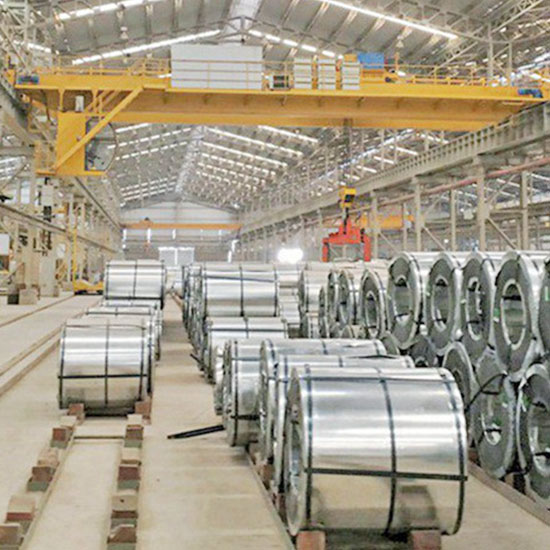

Assembly and SubAssembly
Typical Types of Cranes Used:
Single Girder Overhead Cranes: Offers precision and flexibility for moving components during assembly.
Single Leg and Double Girder Gantry Cranes: Provides localized material handling, ideal for assembly workstations.
Crane Design & Capacities:
Designed to facilitate the movement of components during the assembly and subassembly processes.
Capacities vary based on the weight and size of the components being assembled.
Tailored Features for Assembly and SubAssembly Handling:
Precision Control: Ensures accurate positioning during assembly.
Flexibility: Allows for efficient movement within assembly workstations.
Typical Below Hook Devices Uses:
Specialized Clamps or Grippers: Custom attachments designed for secure handling of assembly components.
Mold Handling
Typical Types of Cranes Used:
Single Girder Overhead Cranes: Provides precise control for the careful handling of molds.
Single Leg Gantry Cranes: Offers flexibility in localized mold handling within dedicated sections.
Crane Design & Capacities:
Designed to emphasize the importance of precise and safe handling of molds during the manufacturing process.
Capacities tailored to the weight and dimensions of different mold types.
Tailored Features for Mold Handling:
Dedicated Sections: Ensures a specialized area for precise and safe mold handling.
Customizable Configurations: Adaptable to handle molds of various sizes and shapes.
Typical Below Hook Devices Uses:
Vacuum Lifters: Provides a secure grip for lifting molds without causing damage.
Mold Hooks: Designed specifically for the safe handling of molds.


Transportation Within the Facility
Typical Types of Cranes Used:
Single Girder Overhead Cranes: Efficient for transporting components within the manufacturing facility.
Single Leg and Double Leg Full Gantry Cranes: Provides flexibility in moving components from one workstation to another.
Crane Design & Capacities:
Designed to facilitate the efficient transportation of components within the designated facility.
Capacities vary based on the weight and size of the components being transported.
Tailored Features for Transportation Within the Facility:
Maneuverability: Ensures easy movement within the facility layout.
Adaptability: Suited for transporting components between workstations.
Typical Below Hook Devices Uses:
Spreader Bars: Enables the simultaneous lifting of multiple components for efficient transportation.
Finished Products
Typical Types of Cranes Used:
Double Girder Overhead Cranes: Offers high lifting capacity for moving completed formwork systems.
Double Leg Gantry Cranes: Provides stability and enhanced lifting capacity, ideal for handling finished products.
Crane Design & Capacities:
Designed to efficiently move and position completed formwork systems, including molds.
Capacities tailored to the weight and dimensions of finished products.
Tailored Features for Finished Products Handling:
High Lifting Capacity: Essential for lifting and positioning completed formwork systems.
Stability: Ensures secure handling of finished products.
Typical Below Hook Devices Uses:
Specialized Lifters: Custom attachments designed for secure and precise handling of finished formwork systems.

This overview outlines the typical types of overhead cranes and gantry cranes used for handling various parts in a formwork manufacturing plant, highlighting their specific design features, capacities, and the use of below hook devices for efficient material handling.
How to Get Your Custom Material Handling Overhead Cranes
Acquiring custom material handling overhead cranes for large formwork manufacturing systems involves a systematic process to ensure that the cranes meet the specific requirements of your manufacturing facility. Here's a stepbystep guide on how to proceed:
- Assess Your Requirements: Define the specific needs of your formwork manufacturing plant. Consider factors such as the types and sizes of formwork components, the layout of your facility, and any unique challenges or constraints.
- Determine Load Capacity: Calculate the maximum load capacity your overhead cranes need to handle. This includes considering the weight of the largest formwork components, molds, and any other materials in your manufacturing process.
- Evaluate the Workspace: Assess the layout and dimensions of your manufacturing plant. Consider factors such as the height and span required for the cranes to operate efficiently within your facility.
- Identify Special Features: Determine any special features required for your custom overhead cranes. This could include features like precise control, specialized attachments for mold handling, or any other unique functionalities based on your manufacturing processes.
- Select the Crane Type: Choose the appropriate type of overhead crane based on your requirements. Consider whether single girder or double girder cranes are more suitable, as well as any additional features such as customization for outdoor use, if needed.
- Safety Considerations: Prioritize safety features in your custom overhead cranes. This may include overload protection, emergency stop systems, collision avoidance technology, and other safety measures to ensure a secure working environment.
- Consult with Crane Manufacturers: Reach out to reputable crane manufacturers or suppliers with experience in designing custom solutions for large formwork manufacturing systems. Provide them with detailed specifications and discuss your specific needs.
- Customization Discussions: Work closely with the crane manufacturer to customize the design based on your requirements. Discuss aspects such as controls, automation, and any unique features needed for efficient material handling in your plant.
- Review and Approval: Review the proposed design and specifications provided by the crane manufacturer. Ensure that it aligns with your requirements and meets industry standards. Seek any necessary approvals from relevant authorities.
- Installation and Training: Once the custom overhead cranes are manufactured, coordinate the installation process. Ensure that your team receives proper training on operating and maintaining the cranes safely.
- Regular Maintenance and Inspection: Establish a routine maintenance and inspection schedule for your custom overhead cranes. Regular checks and preventive maintenance will contribute to the longevity and reliability of the equipment.
- Continuous Communication: Maintain an open line of communication with the crane manufacturer for any future needs or modifications. Regularly assess the performance of the custom overhead cranes and provide feedback for potential improvements.
By following these steps and collaborating closely with experienced crane manufacturers, you can obtain custom material handling overhead cranes tailored to the specific requirements of your large formwork manufacturing systems.
In conclusion, effective material handling is the backbone of successful construction projects involving large formwork systems. Overhead cranes and gantry cranes play pivotal roles in lifting, positioning, and transporting materials, including molds, with precision. The customizability of these cranes ensures adaptability to unique manufacturing requirements.
Safety remains paramount, with advanced features and regular maintenance contributing to a secure working environment. The dance of cranes, from receiving raw materials to dispatching finished products, orchestrates the construction symphony. Embracing the capabilities of custom material handling solutions enhances efficiency, ensuring a legacy of precision, safety, and excellence in construction endeavors.
Related Products
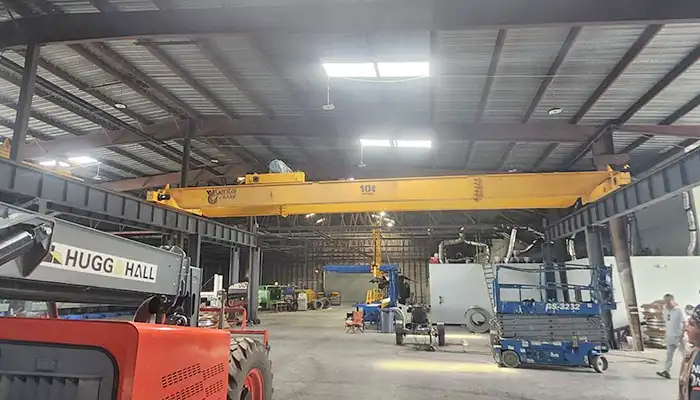
Affordable 10 ton double girder overhead crane with CD/MD hoist trolley, built for U.S. standards, ideal for construction and industrial lifting
Free consultation to Confirm Parameters & Specifications and Get
Latest Crane Price & Crane Rate.
- Types of overhead cranes : _______?
- Optional: Overhead travelling crane, goliath gantry crane,Slewing jib crane, Single girder or double girder crane,small portable crane or kbk crane, etc.
- Capacity of overhead crane: _______?
- Optional: 0.25ton, 0.5 ton, 1 ton, 2 ton, 3ton, 5 ton, 10 ton,15ton, 20ton, 25 ton, 30ton,35ton, up to 550ton, etc.
- Crane span & lifting height : _______?
- Crane travelling length : _____?
- Control of overhead crane:_______?
- Optional: pendant/ remote/cabin control
- Voltage supply of overhead crane:_____?
- Eg,: 380V50/60HZ,3Phase or others,etc.
- Application/usage of crane:_______?
- Eg,: Steel mill, ,injection mold, cement,stone, concrete,granite, general manufacturing, etc.
Just leave a message via the contact form and our hoist and crane engineer will contact you with in 24working hours.
Get In Touch
